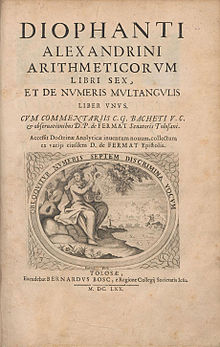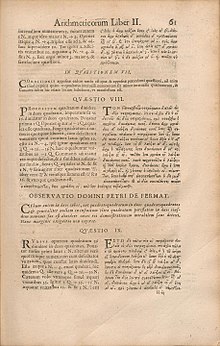Fermat's Last Theorem
Fermat's Great Theorem was formulated in the 17th century by Pierre de Fermat, but was not proved until 1994 by Andrew Wiles. The conclusive culmination for the proof is considered to be the collaboration of Wiles with Richard Taylor, which, in addition to the final proof by Wiles, resulted in a simultaneous publication of a partial proof by both Wiles and Taylor as joint authors.
The theorem states: If 

with positive integers 


Fermat's Great Theorem is considered unusual in many respects. Its statement, despite the difficulties encountered in its proof, is easily understood even by laymen. It took more than 350 years and was a story of failed attempts, in which, since Leonhard Euler, numerous leading mathematicians such as Ernst Eduard Kummer have participated. Numerous partly romantic, partly dramatic, but also tragic episodes of this story have made it popular far beyond the circle of mathematicians.
The proof finally produced, in the preliminary work of which Gerhard Frey, Jean-Pierre Serre, Barry Mazur and Ken Ribet were also involved in addition to Wiles and Taylor, is regarded as the high point of 20th century mathematics.

Pierre de Fermat
Designations
There are different names for this theorem. The most common one in German is Großer Fermatscher Satz and derived from it Großer Fermat in contrast to Kleiner Fermatschen Satz or Kleiner Fermat. Since no proof has been handed down by Fermat himself, strictly speaking it was initially only a conjecture. Therefore the term Fermat's conjecture is also used, but even before the proof was spoken of Fermat's theorem. To include Wiles, the finder of the proof, there is also talk of the Fermat-Wiles theorem. In English, the theorem is called Fermat's Last Theorem, which is sometimes (inaccurately) translated in German as Fermat's letzter Satz or Fermat's letztes Theorem.
Source
Probably between 1637 and 1643, an exact year cannot be given due to the following circumstances, Fermat wrote the following lines as a marginal note in his hand copy of the Arithmetika of Diophantos of Alexandria next to the 8th problem of the second (Greek) "book":
"Cubum autem in duos cubos, aut quadratoquadratum in duos quadratoquadratos, et generaliter nullam in infinitum ultra quadratum potestatem in duas ejusdem nominis fas est dividere: cujus rei demonstrationem mirabilem sane detexi. Hanc marginis exiguitas non caperet."
"It is not possible, however, to decompose a cube into 2 cubes, or a biquadrate into 2 biquadrates, and in general to decompose a power, higher than the second, into 2 powers with the same exponent: I have discovered a truly wonderful proof of this, but this margin is too narrow here to contain it."
Since Fermat's hand copy of the Arithmetika was found by his son in his father's estate only after his death and he did not date his marginal notes, an exact date cannot be determined. But it is plausible to assume that Fermat 

That Fermat 

The theories used in Wiles' proof in 1995 were not even rudimentarily developed over 350 years earlier. This does not exclude with certainty that one day a simpler proof will be found, using more elementary means. But that Fermat could have found one is doubted by most number theorists today. The surest sign that Fermat soon realized that he had not found a proof after all is that he did not mention the theorem and a proof of it to any of his correspondents. Fermat's marginal remark, moreover, was intended only for himself. He could not have counted on its publication by his son Samuel.

Book cover of the version of the Arithmetica of Diophantos published by Pierre de Fermat's son Clément-Samuel in 1670 with his father's remarks

This page of the Arithmetica of 1670 contains Pierre de Fermat's marginal note
Questions and Answers
Q: What is Fermat's Last Theorem?
A: Fermat's Last Theorem (FLT) states that if n is a whole number larger than 2, then the equation x^n + y^n = z^n has no solutions when x, y and z are natural numbers. In other words, it is impossible to express in whole numbers two cubes which added equal a third cube or anything higher than squares.
Q: When was FLT written?
A: Pierre de Fermat wrote about FLT in 1637 inside his copy of a book called Arithmetica.
Q: What did Fermat say about the theorem?
A: He said "I have a proof of this theorem, but there is not enough space in this margin".
Q: How long did it take for FLT to be proven?
A: It took 357 years for FLT to be proven correctly; it was finally done in 1995.
Q: Do mathematicians think that Fermat had an actual proof of the theorem?
A: Most mathematicians do not think that Fermat actually had a margin proof of this theorem.
Q: What does the original problem state?
A: The original problem states that it is impossible to divide cubum autem (a cube) into two cubes or quadratoquadratum (a square-square) into two square-squares and generally nothing beyond squares can be divided into two of its same name, with demonstration being remarkable yet too large for the margin size.
Search within the encyclopedia
